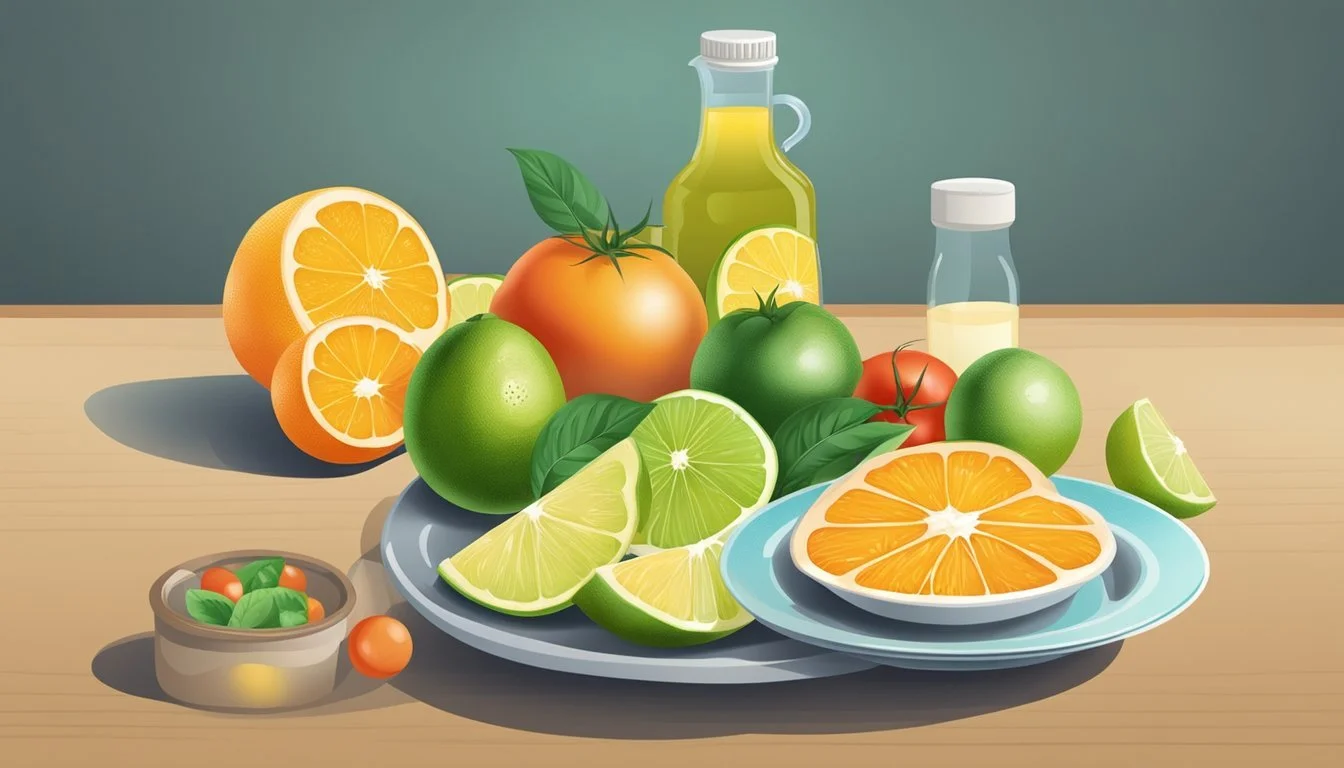8 Common Foods High in Acid
What You Need to Know
The consumption of foods high in acid is a topic of growing interest among health-conscious individuals. These foods can have various effects on the body, influencing everything from digestion to dental health. Understanding which foods are high in acid and their potential impact is crucial for making informed dietary choices.
For those looking to manage their diet more effectively, it is important to be aware of which everyday items contribute to increased acidity levels. This awareness can aid in reducing potential health risks and promoting overall well-being.
1) Lemons
Lemons are well-known for their high citric acid content. This gives them a low pH, placing them firmly in the acidic food category. The pH of lemon juice ranges between 2 and 3, making it 10,000-100,000 times more acidic than water.
Lemons are often consumed for their distinct sour taste and are widely used in cooking and beverages. Despite their acidity, they are also rich in vitamin C and other antioxidants, contributing to various health benefits.
Regular consumption of lemons can have potential risks. Their high citric acid content may erode tooth enamel if consumed excessively. It's advisable to consume lemon-based drinks and foods in moderation to maintain dental health.
In addition to their culinary uses and health benefits, lemons' acidic nature can impact the body’s pH balance. They are often included in discussions about acid-forming foods and their effects on the body. Although popular in many diets, moderation is key to avoiding potential dental issues.
2) Grapefruits
Grapefruits are a well-known citrus fruit that is highly acidic. They contain significant amounts of citric acid, which contributes to their tart taste. This high acidity can affect people who suffer from acid reflux or other digestive issues, making it essential for them to monitor their intake.
In addition to citric acid, grapefruits also contain malic acid and tartaric acid. These acids contribute to the overall acidity of the fruit and may irritate the esophagus for those predisposed to acid reflux.
Despite their acidity, grapefruits are rich in vital nutrients. They provide high levels of vitamin C and vitamin A, alongside essential minerals like potassium and magnesium. These nutrients support various bodily functions and promote overall health.
People who are sensitive to acidic foods should consider moderated consumption of grapefruits. The acidity can relax the esophageal sphincter, potentially allowing stomach contents to escape and aggravate acid reflux symptoms.
For those who can tolerate it, grapefruit can be a healthy addition to the diet due to its low fat content and high fiber. This balance of nutrients offers multiple health benefits for those without acid sensitivities.
3) Limes
Limes are a popular citrus fruit known for their high acidity. Their pH level generally falls between 2 and 3, making them quite acidic compared to many other foods. This acidity is a result of the presence of citric acid, which is a prominent compound in limes.
High in vitamin C, limes can contribute significantly to the recommended daily intake. A single lime can provide around 32% of an individual's vitamin C needs. This makes them a valuable addition to the diet, especially for boosting immunity.
Despite their benefits, it's important to consume limes in moderation. Their high citric acid content can erode tooth enamel if consumed excessively. Additionally, applying lime juice directly to the skin can cause irritation due to its acidity.
Limes also contain flavonoids and other antioxidants, which have various health benefits. These compounds help protect the body from free radicals, potentially lowering the risk of chronic diseases.
In culinary uses, the acidity of limes makes them ideal for adding a tangy flavor to dishes and beverages. They are often used in marinades, dressings, and desserts to enhance the overall taste.
4) Oranges
Oranges are well-known for their acidic nature. With a pH level around 3, they are considered highly acidic. This acidity comes from their citric acid content, which is a defining characteristic of citrus fruits.
Despite their acidity, oranges are packed with essential nutrients. They are an excellent source of Vitamin C, which supports the immune system and aids in collagen production. Other beneficial components include fiber, potassium, and various antioxidants.
Consuming oranges can have health benefits but should be moderated if someone is sensitive to acidic foods. These individuals might experience discomfort such as heartburn or acid reflux. Nonetheless, for most people, the nutritional benefits of oranges outweigh the acidity concerns.
Oranges can be enjoyed fresh, in juice form, or as part of various dishes. Their versatile nature makes them a popular fruit across different cuisines and dietary patterns.
5) Pineapples
Pineapples are a tropical fruit known for their sweet yet tangy taste. Their acidity levels range between pH 3.20 and 4.00.
The acidity in pineapples can potentially trigger acid reflux in individuals sensitive to acidic foods. People with chronic acid reflux are often advised to avoid high-acid foods, including pineapples.
Despite their acidity, pineapples are rich in nutrients. They contain an enzyme called bromelain, which some believe aids digestion.
For those not affected by acid reflux, pineapples can offer health benefits, including vitamin C and antioxidants. However, moderation is key, especially for those prone to acid reflux.
6) Tomatoes
Tomatoes are known for their high acidity, with a pH value typically ranging between 4.2 and 4.9. This makes them a staple acidic food. The acidity in tomatoes primarily comes from several types of acids, including citric acid, malic acid, ascorbic acid (vitamin C), and folic acid.
Different varieties of tomatoes can have varying levels of acidity. For instance, cherry tomatoes often have a sweeter taste due to a different balance of sugars and acids, while larger tomatoes like beefsteak types can be more acidic.
In cooking, tomato acidity can influence the flavor and preservation of dishes. Acidic tomatoes can add a sharp tang to sauces and soups. The acid content also helps in canning and preserving tomatoes, keeping them safe for longer periods.
Tomato acidity can impact those with acid reflux or sensitive stomachs. The acid content may increase stomach acid levels, which can exacerbate reflux symptoms. For some, it might be beneficial to limit tomato intake or prepare tomatoes in a way that reduces their acidity, such as removing the seeds.
Tomatoes are not just about taste and culinary uses; their acidity also has nutritional implications. The presence of vitamin C and other acids can offer health benefits but should be consumed in moderation by those needing to manage their acid intake.
7) Vinegar
Vinegar is a popular, acidic food ingredient known for its characteristic tart flavor. It contains acetic acid, which is responsible for its sharp taste and preservative qualities. For vinegar to be considered vinegar in the United States, it must contain at least 4% acetic acid by volume.
Vinegar is made through a two-step fermentation process. Initially, yeast converts the sugars or starches from plant-based foods, like fruits and grains, into alcohol. Subsequently, bacteria known as Acetobacter convert this alcohol into acetic acid.
Different types of vinegar include apple cider vinegar, balsamic vinegar, and white vinegar, each varying in flavor and acetic acid concentration. While the acetic acid content is consistent within each type, varying them offers versatile culinary uses from salad dressings to pickling.
Due to its high acidity, vinegar can serve as a strong preservative, inhibiting the growth of harmful bacteria. This trait contributes to its long shelf life, with some suggesting that vinegar can last indefinitely if stored properly. This makes vinegar a practical addition to any pantry.
Vinegar's acidity makes it a potential trigger for acid reflux and heartburn in those with sensitivities. People prone to these conditions might consider moderating their vinegar intake to avoid discomfort.
8) Sour Cherries
Sour cherries, often referred to as tart cherries, are known for their pronounced acidity. They have a pH range of about 3.2 to 3.5. This low pH level contributes to their sharp and tangy taste, making them a popular choice for various culinary uses.
Unlike their sweeter counterparts, sour cherries are typically too tart to be consumed fresh. Instead, they are commonly used in baking, jams, jellies, and sauces. The acidity in sour cherries enhances the flavor of desserts and other dishes, providing a pleasant contrast to sweet ingredients.
Sour cherries, such as the Montmorency variety, also contain beneficial antioxidants. Despite their sharp taste, they offer nutritional benefits, which can make them a valuable addition to a balanced diet.
The acidic nature of sour cherries enables them to preserve well, which is why they are often found in canned or frozen forms. These preservation methods allow people to enjoy the distinctive taste of sour cherries year-round.
For those monitoring their acid intake, sour cherries are a notable fruit due to their significant acidity. This characteristic makes them stand out among other stone fruits like peaches and plums, which have higher pH levels and milder acidity.
9) Green Apples
Green apples, known for their tart flavor, have a pH value ranging from 3.34 to 3.9. This indicates they are highly acidic. Compared to red apples, their acidity might exacerbate symptoms of acid reflux in some individuals.
Despite their acidity, green apples offer health benefits, including vitamins, fiber, and antioxidants. These nutrients support overall well-being but should be consumed in moderation by those prone to acid reflux.
For those managing acid-related issues, opting for less acidic apple varieties, like red apples, might be a better choice. Eating green apples occasionally should be fine, but monitoring individual reactions is essential to avoid discomfort.
10) Plums
Plums are known for their tart flavor and vibrant color. They are categorized as acidic fruit, with a pH level typically falling below 4.6.
The acidity in plums can contribute to digestive discomfort for individuals prone to acid reflux. They should be consumed in moderation by those watching their acid intake.
Despite their acidity, plums are rich in vitamins and antioxidants. They offer several health benefits, including improving gut health and providing essential nutrients.
Plums can be enjoyed fresh, dried, or in various culinary preparations. While delicious, it's important to balance their acidity with less acidic foods for a well-rounded diet.
Understanding Acidic Foods
When it comes to dietary choices, understanding which foods are high in acid can help manage certain health conditions and promote overall well-being. Key points include identifying acidic foods and understanding why some foods are high in acid.
What Are Acidic Foods?
Acidic foods are those that typically have a lower pH level, generally below 7. These foods can increase the acidity of the body's internal environment. Common acidic foods include certain fruits and vegetables, dairy products, grains, and processed foods.
Examples of acidic foods:
Fruits: Citrus fruits (lemons, oranges, grapefruits)
Dairy: Cheese, yogurt
Grains: Wheat, rice
Processed Foods: High-sodium snacks, canned soups
It's important to note that not all acidic foods are unhealthy. Many provide essential nutrients and can be part of a balanced diet.
Why Some Foods Are High in Acid
The acidity of food is influenced by its natural chemical composition. Fruits like lemons and tomatoes contain organic acids such as citric and malic acid, which contribute to their acidity.
Processed foods often have added acids or high sodium content, which can further lower their pH. For example, condiments like soy sauce and barbecue sauce are acidic due to additives and preservatives.
Factors contributing to high acidity:
Natural acids: Citric acid, malic acid
Added preservatives: Sodium benzoate, citric acid
Fermentation: Produces lactic acid in yogurt and sauerkraut
Understanding these factors helps consumers make informed dietary choices, ensuring they maintain a balanced intake of acidic and alkaline foods.
Health Implications
High-acid foods can influence your body in several ways, affecting both digestion and dental health. Understanding these effects helps make informed dietary choices.
Effects On Digestion
Acidic foods can cause discomfort in the digestive system. Citrus fruits, tomatoes, and soft drinks may lead to heartburn or acid reflux. People with gastroesophageal reflux disease (GERD) often find that acid-heavy diets aggravate their symptoms.
An overly acidic diet can also disrupt the acid-base balance of the stomach. This imbalance can reduce the stomach's efficiency in breaking down food, potentially leading to digestive issues. High acidity levels in the diet have been linked to conditions like low-grade metabolic acidosis, a state where the body has more acid than it can efficiently neutralize.
Monitoring the intake of acidic foods can help manage these digestive issues effectively.
Impact On Dental Health
Consumption of acidic foods poses risks to dental health. Acidic food and drink can erode tooth enamel, the outer protective layer of teeth. Enamel erosion leads to tooth sensitivity and an increased risk of cavities. Common acidic culprits include citrus fruits, carbonated beverages, and foods with high vinegar content, like pickles.
Frequent exposure to acidic substances creates a vulnerable environment for bacteria to thrive, contributing to tooth decay. Acidic foods can also dry out the mouth, reducing saliva production—a natural defense against harmful bacteria.
To mitigate these effects, maintaining oral hygiene and moderating acidic food intake is crucial. Additionally, drinking water after consuming acidic items helps neutralize the acidity and protect the teeth.
Proper dental care can prevent long-term damage from acidic diets.







